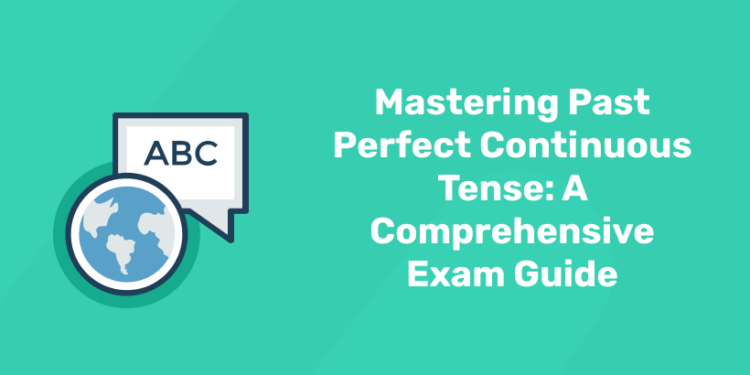Table of Contents
English grammar is a complex web of tenses, each serving a distinct purpose in conveying time relationships. Among these, the past perfect continuous tense is used for expressing ongoing actions in the past, especially in relation to other events. This article provides comprehensive exam guide which will help you master the past perfect continuous tense, enabling you to use it confidently in both written and spoken communication.
Past Perfect Continuous Tense – Exam Guide
The Past Perfect Continuous tense is a grammatical structure used to describe actions that were ongoing in the past before another action or event took place. It emphasizes the duration of an action in the past and its relevance to a specific point or another action.
Formation of the Past Perfect Continuous Tense
1: Which of the sentences below is grammatically correct?
- Affirmative Sentences: Subject + had been + base verb + -ing + object Example: She had been studying for hours before the party started.
- Negative Sentences: Subject + had not been + base verb + -ing + object Example: They had not been working together for long before the disagreement arose.
- Interrogative Sentences: Had + subject + been + base verb + -ing + object + ? Example: Had you been waiting for a long time before the bus arrived?
- Negative Interrogative Sentences: Hadn’t + subject + been + base verb + -ing + object + ? Example: Hadn’t they been playing tennis before the rain started?
Elevate your speaking skills with our Spoken English Course! Get Free Demo Here!
Spoken English Course for Guaranteed Confidence and Career Growth
Spoken English Course by Entri App: Enhance your communication skills, gain certification, and boost your career with confidence.
Join Now!Usage of the Past Perfect Continuous Tense
- Describing Duration in the Past: This tense is ideal for expressing how long an action had been happening before another action or event in the past.Example: She had been practicing the piano for years before she performed in front of an audience.
- Actions Before Another Action: It highlights actions that were ongoing in the past before a specific point or another action took place.Example: They had been traveling for days when they finally reached their destination.
- Parallel Actions in the Past: The past perfect continuous tense can depict multiple actions happening simultaneously in the past.Example: While John had been cooking dinner, Sarah had been setting the table.
- Reporting Past Actions in a Story: It’s useful for narrating past events and actions to provide context and flow to your storytelling.Example: The detective explained how he had been investigating the case for months before he cracked it.
Tips for Mastering Past Perfect Continuous Tense
Mastering the past perfect continuous tense is an invaluable skill that elevates your language proficiency. Through a firm grasp of its formation, usage, and common mistakes, you can confidently navigate the intricacies of past events and their relationships, making your communication more engaging, precise, and impactful. Below are the tips for mastering past perfect continuous tense.
1. Signal Words and Time Expressions
Signal words like “for,” “since,” “all day,” and “by the time” help identify situations where the past perfect continuous tense is appropriate. These words provide a temporal context for understanding the sequence of events.
2. Differentiating from Other Tenses
Distinguishing the past perfect continuous tense from other tenses like the past perfect, past continuous, and simple past is crucial to ensure accuracy in your communication.
3. Mistakes to Avoid
Common errors include using the wrong tense, misplacing signal words, or overusing the past perfect continuous tense. Being mindful of these pitfalls enhances your linguistic precision.
4. Exercises and Practice Questions
Engaging in exercises that involve transforming sentences, filling in the blanks, and crafting paragraphs helps solidify your grasp of the tense.
5. Real-Life Application
From business emails to creative writing, understanding the past perfect continuous tense empowers you to convey actions and events in a more sophisticated and coherent manner.
6. Final Review and Exam Strategies
Summarize key concepts, review signal words, and devise strategies for tackling tense-related questions in exams to ensure success.
Join our Spoken English program today and communicate with ease!
Past Perfect Continuous Tense Exercises
Consistent practice is key to mastering the Past Perfect Continuous tense. These exercises will help you reinforce your understanding and improve your ability to use this tense accurately.
Exercise 1: Fill in the Blanks
Fill in the blanks with the appropriate form of the Past Perfect Continuous tense (positive or negative).
- I was exhausted because I __________ (work) in the office all day.
- By the time Rahul arrived, I __________ (wait) for over an hour.
- They were tired because they __________ (hike) up the mountain.
- When I called, he __________ (study) for his final exams.
- She felt better after she __________ (rest) for a while.
Exercise 2: Rewrite the Sentences
Rewrite the sentences using the Past Perfect Continuous tense.
- Tom started feeling ill. He had been eating too much junk food.
- The concert started. We had been waiting for it for months.
- They stopped playing tennis. They had been playing since morning.
- The fire alarm rang. The chefs had been cooking for hours.
- The rain stopped. They had been walking in the rain for an hour.
Exercise 3: Complete the Story
Complete the following story by filling in the gaps with the correct form of the Past Perfect Continuous tense.
Once upon a time, there (1. be) a scientist named Dr. Andrew. He (2. work) on an experiment for months. He (3. try) to develop a new energy source. By the time he finally succeeded, he (4. work) day and night without rest. His dedication and hard work paid off when he (5. create) a revolutionary device that could produce clean energy. The world (6. face) energy shortages for years, and his invention was a game-changer. Everyone (7. wait) eagerly for his presentation at the energy conference. When he stepped onto the stage, he (8. look) tired but triumphant. The audience (9. listen) attentively as he explained how he (10. strive) to achieve this breakthrough.
Exercise 4: Dialogue Completion
Complete the dialogue using the Past Perfect Continuous tense.
A: Why were you so tired yesterday? B: I __________ (paint) the living room all day. A: Really? How long __________ you __________ (paint)? B: I __________ (paint) for nearly eight hours by the time I stopped.
Answers
Exercise 1: Fill in the Blanks
- I was exhausted because I had been working in the office all day.
- By the time Rahul arrived, I had been waiting for over an hour.
- They were tired because they had been hiking up the mountain.
- When I called, he had been studying for his final exams.
- She felt better after she had been resting for a while.
Exercise 2: Rewrite the Sentences
- Tom had been feeling ill because he had been eating too much junk food.
- We had been waiting for the concert for months when it started.
- They had been playing tennis since morning, but they stopped.
- The chefs had been cooking for hours when the fire alarm rang.
- They had been walking in the rain for an hour when it stopped.
Exercise 3: Complete the Story
Once upon a time, there was a scientist named Dr. Andrew. He had been working on an experiment for months. He had been trying to develop a new energy source. By the time he finally succeeded, he had been working day and night without rest. His dedication and hard work paid off when he created a revolutionary device that could produce clean energy. The world had been facing energy shortages for years, and his invention was a game-changer. Everyone had been waiting eagerly for his presentation at the energy conference. When he stepped onto the stage, he looked tired but triumphant. The audience listened attentively as he explained how he had been striving to achieve this breakthrough.
Exercise 4: Dialogue Completion
A: Why were you so tired yesterday?
B: I had been painting the living room all day.
A: Really? How long had you been painting?
B: I had been painting for nearly eight hours by the time I stopped.
Remember that mastering the Past Perfect Continuous tense can greatly enhance your language skills and help you convey complex temporal relationships with precision and clarity. With practice and dedication, you will be able to make your communication more engaging, precise, and impactful.
Past Perfect Continuous Tense FAQ
1. What is the Past Perfect Continuous tense?
2. How is the Past Perfect Continuous tense formed?
Ans: The Past Perfect Continuous tense is formed using the past perfect of the auxiliary verb “have” (had), followed by “been,” and then the base form of the main verb plus “-ing.”
Affirmative: Subject + had been + base verb + -ing + object
Negative: Subject + had not been + base verb + -ing + object
Interrogative: Had + subject + been + base verb + -ing + object + ?
Negative Interrogative: Hadn’t + subject + been + base verb + -ing + object + ?
3. What’s the difference between Past Perfect Continuous and Past Perfect tenses?
Ans: The Past Perfect Continuous tense emphasizes the ongoing nature of an action in the past, highlighting its duration up to a specific point. The Past Perfect tense focuses on the completion of an action before another action in the past.
Example Past Perfect Continuous: She had been studying for hours before the party. Example Past Perfect: She had studied before the party started.
4. When do I use the Past Perfect Continuous tense?
Ans: Use it to:
- Describe actions that were ongoing in the past before a specific point or action.
- Emphasize the duration of an action before another action or event.
- Indicate parallel actions happening in the past.
- Provide context when narrating events in a story.
speak english like a native with spoken englsh course !
5. What are some signal words for the Past Perfect Continuous tense?
6. Can I use the Past Perfect Continuous tense in future situations?
7. Is the Past Perfect Continuous tense used in spoken English?
8. Can the Past Perfect Continuous tense be used in all verb forms (base, present, past)?
9. Can the Past Perfect Continuous tense be used in all situations?
10. How can I improve my mastery of the Past Perfect Continuous tense?










